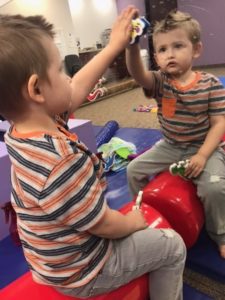Mirror Neuron Therapy in the Pediatric Setting
by Hailee Baryshnikov
Student Physical Therapist
Mirror neurons are a type of brain cell that respond equally when we perform an action and when we witness someone else perform the same action. They were first discovered in the early 1990s, when a team of Italian researchers found individual neurons in the brains of Macaque monkeys that fired both when the monkeys grabbed an object and also when the monkeys watched another primate grab the same object. Research quickly transitioned from primates to humans.
The neurons in our bodies can undergo plasticity, a term defined as the ability to adapt and regrow. Mirror neurons have this same property and research has shown that they develop best when both observation and demonstration of an activity takes place. Physical therapy, speech therapy, and occupational therapy all use the development of the mirror neuron system (MNS) to achieve goals in the pediatric setting.
Physical therapists often address the MNS to facilitate functional movements and improve coordination in the pediatric setting. They do this by demonstrating the mirror image of what they want the child to perform as many times as needed for the child to start to imitate the activity independently. The therapists can demonstrate the activity or they can use a mirror to allow the child to visually see themselves performing the activity and self-correct to imitate the task. Research has also shown that the use of video games such as the Wii Fit and Kinect 360 can provide the same stimulation to the mirror neurons providing another resource and motivating activity for the pediatric population. MNS therapy has shown to be the most effective with children diagnosed with Cerebral Palsy in the pediatric populations.
Autism is another common diagnosis in the pediatric therapy setting that has a direct correlation to MNS. Children with autism appear to have a dysfunctional mirror neuron system. The more severe the symptoms of autism, the less active the mirror neuron system. Studies have demonstrated that children with autism have difficulties understanding the intention of others on the basis of the action they observe. They need to see a demonstration as well as link it to a functional purpose to be able to imitate the task. This may be one of the reasons why children with autism do not often imitate facial expressions and do not demonstrate empathy.
It is important that therapists use the MNS when appropriate to facilitate the most progress and help children reach their full potential with therapy services.
References
Effects of Mirror Neurons Stimulation on Motor Skill Rehabilitation in Children with Cerebral Palsy – Study Results – ClinicalTrials.gov. (2017). Clinicaltrials.gov. Retrieved 18 May 2017, from https://clinicaltrials.gov/ct2/show/results/NCT01267929?sect=X70156#outcome1
Kommalapati, R., & Michmizo, K. Virtual Reality for Pediatric Neuro-Rehabilitation: Adaptive Visual Feedback of Movement to Engage the Mirror Neuron System.
Mirror Neurons – BrainFacts.org. (2017). Brainfacts.org. Retrieved 18 May 2017, from http://www.brainfacts.org/Brain-Basics/Neuroanatomy/Articles/2008/Mirror-Neurons
The mind’s mirror. (2017). http://www.apa.org. Retrieved 18 May 2017, from http://www.apa.org/monitor/oct05/mirror.aspx








